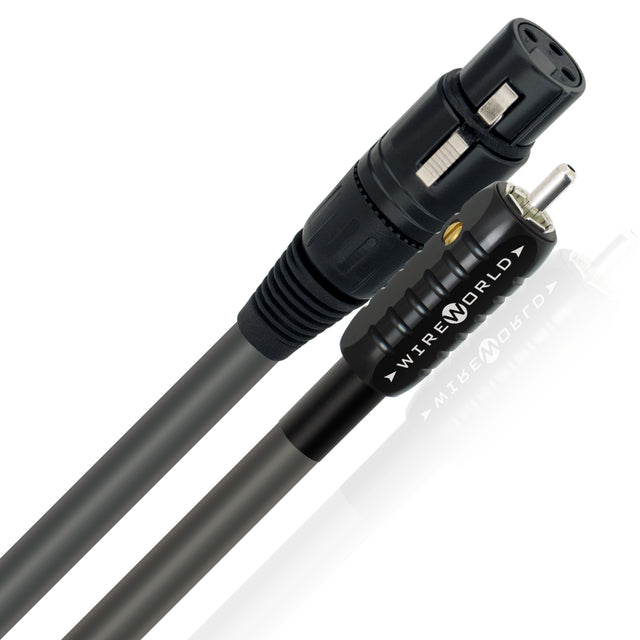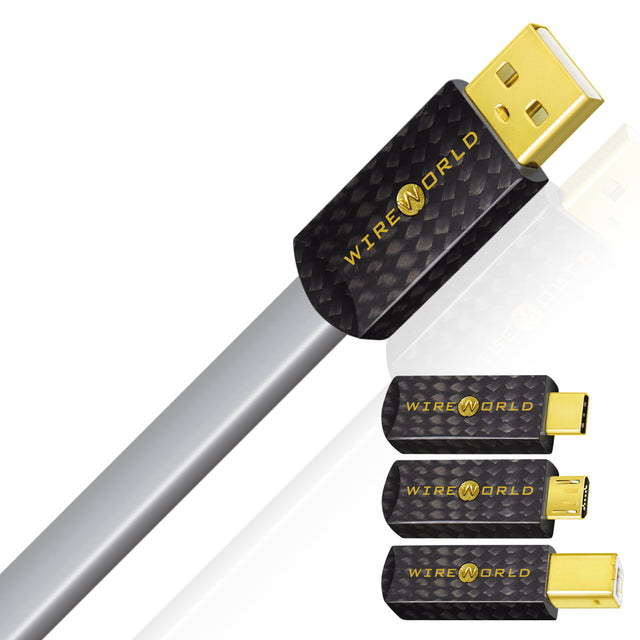Cable Comparator
(US Patent #5,740,255)
In engineering, a comparator is a device for comparing something with a reference standard. Wireworld Cable Comparators are custom-built laboratory grade devices that facilitate instant comparisons between cables and the only scientific reference standard for cable performance, a direct connection between components, which is essentially a perfect cable. We call these tests Cable Polygraphs and they can also be performed manually or by re-recording music that has passed through the cables and a reference direct connection.

Cable Colorations
Most cables feature brightness added to the sound because their electromagnetic loss creates phase shift that increases the duration of high frequency transients, which makes them sound louder. In comparison, the reduced loss and phase shift of Wireworld cables lets the music breathe, sounding much more organic and vibrant. Individual sounds become more distinct as the whole spectrum gains a faster cleaner attack and decay. Strings sound more delicate, even though their tone intensifies. Quieter sounds become audible and dynamics gain impact.
Cable Polygraph
Wireworld created this term to describe cable listening tests that include a true reference that serves as the test control. These tests can be accomplished with a Cable Comparator or manually, by docking components together with adapters to create the reference or by re-recording music through various cables and a reference connection, which is less effective, but still useful. The importance of these tests cannot be overstated, as they provide the only proof that standard cables degrade fidelity. If no degradation is audible in a particular application, then cable upgrades are not possible, however that result has been rare in our experience.

Eddy Currents
Eddy currents in cables, like those in rivers, are swirling currents that slow down the flow. They are created where strands follow a different path than the electromagnetic field. It turns out that most of the coloration and loss we hear from cables is caused by this electromagnetic slowing of fast moving transient sounds. Indeed, recent psychoacoustic research* confirms that humans are far more sensitive to transient sounds than engineers have been taught to believe. Wireworld DNA HELIX technology minimizes those losses with parallel conductors layered in patterns that strengthen the electromagnetic field and reject interference.
*Kunchur, Milind N.: Acta Acustica united with Acustica, Volume 94, Number 4, July/August 2008, pp. 594-603.
Electromagnetic (Inductive) Loss
The most audible differences among interconnects and speaker cables are caused by electromagnetic (inductive) loss, which is the sum of proximity effect, skin effect and the especially problematic eddy current resistance. While some listeners may like certain sonic colorations caused by cable inductance, these effects are always accompanied by dynamic compression and masking of the finer sonic details. For example, speaker cables with widely separated positive and negative conductors exhibit so much inductive loss that they distinctly thin out, blur and compress the sound. The opposite is true for closely spaced conductors, which can preserve music extremely well if properly designed. This is the principle used to create the Delineated Neutralizing Array, or DNA HELIX conductor geometry used in most Wireworld cables. Optimally engineered, closely-spaced conductors reduce electromagnetic losses to provide dramatic improvements in the preservation of harmonic structure, three-dimensionality and dynamics.
Jitter
Timing errors that reduce fidelity in digital signal transmission. Digital audio cables with superior waveform fidelity reduce jitter.
OCC-7N
The patented Ohno Continuous Casting® process creates the world’s purest (99.99999% = 7 Nines) copper and silver conductors. OCC-7N conductors also have the longest grain structure and smoothest surfaces. OCC-7N conductors are only produced in Japan and Taiwan.
OFC
Oxygen-free copper is 99.99% (4 Nines) pure, an upgrade over the standard electrolytic grade, which is 99.9% pure.
Silver-Clad / Silver-plated
Since silver is the most conductive metal, adding a layer of silver over copper is a wire feature that can improve performance. We use the term ‘clad’ to describe an extremely thick layer of silver. Our silver-clad cables have about three times as much silver as the related silver-plated model. Silver also makes the quietest and lowest loss connections, even when mated to terminals made of other metals. Silver conductors improve resolution, which can reveal coloration caused by design faults, but in the best designs they simply reveal more music.
Triboelectric Noise
Noise generated in cables by the interface of conductors and insulation materials where static charge and discharge effects are induced by movement, vibration and signal energy. Polygraph testing has shown that Triboelectric noise causes much of the coloration we hear from cables. It is the primary reason that various cable insulation materials produce different sound effects. Composilex 3 minimizes these effects to reveal the lifelike harmonic structure of the original sound.
More stories

Hands on: Wireworld Cables Built to Withstand Wear and Tear


